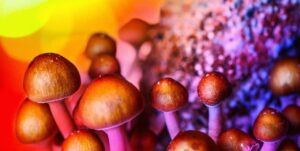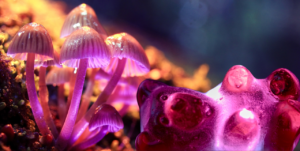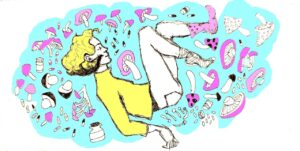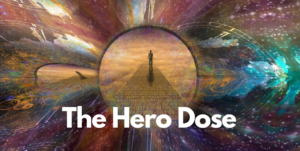People have been using psilocybin for thousands of years for religious and spiritual reasons, recreation and more. But in the last 100 years “magic mushrooms” were prohibited in many countries as a potentially harmful drug. You’ve probably heard of the “magic mushrooms” drug before, and may be unsure as to whether they’re safe. They’ve been made illegal for a reason, right?
Well, not so fast; maybe what you’ve been told about these fungi isn’t exactly accurate. The five reasons below should illuminate a few important truths about the “magic mushrooms” drug. Turns out, they aren’t as evil as they’ve been made out to be.
A bad rep from the war on drugs
Probably the main reason society views magic mushrooms, and psychedelics in general, as a bad things is the War on Drugs. The whole thing started in the U.S. in 1971 with the Controlled Substances Act. Psychedelics were initially made illegal in 1968, but the government didn’t strictly enforce those laws until three years later. As we now know, the War on Drugs was and continues to be a massive failure. The main goals of this “war” was to to subdue minorities as well as the rising anti-war movement and freethinking ‘hippies,’ by criminalizing often largely harmless behavior and substances. The enforcement of the Controlled Substances Act disproportionately targets urban areas, predominantly low-income neighborhoods and communities of color.
 Psychedelics, including psilocybin, became classified as Schedule I drugs by the Drug Enforcement Administration (DEA), alongside heroin. This means, according to the federal government, that they have no medical use and are highly addictive. This scheduling actually contradicted the evidence that came out of research on these substances back in the 1950s and 60s, which indicated that psychedelics did, in fact, show promise for treating mood disorders and alcoholism.
Psychedelics, including psilocybin, became classified as Schedule I drugs by the Drug Enforcement Administration (DEA), alongside heroin. This means, according to the federal government, that they have no medical use and are highly addictive. This scheduling actually contradicted the evidence that came out of research on these substances back in the 1950s and 60s, which indicated that psychedelics did, in fact, show promise for treating mood disorders and alcoholism.
Now that we can see how non-science-based policy has shaped the way we see these substances, let’s take a look at the mushrooms drug itself.
Mushrooms are the safest recreational drug
Yep, you read that right. A 2016 survey from the Global Drug Survey found that, out of the 12,000 people who reported taking magic mushrooms, only 0.2% of them required emergency medical attention. This number is at least five times lower than the rate of other recreational drugs such as cocaine, LSD, and MDMA.
It’s also an important to distinguish what “requiring emergency medical attention” means for different substances. For example, requiring emergency attention for heroin or methamphetamines can realistically imply a life-or-death situation. On the other hand, psychedelics like LSD and psilocybin have no toxicity and no known lethal dosage – the effects diminish after several hours. Requiring emergency attention in the case of psychedelics is much more likely due to a psychological reaction, such as a panic attack. Scary, but not life-threatening.
In rare cases, bad trips can cause psychological damage, particularly if precautions aren’t taken. You’ll commonly hear “Set and Setting” being referenced when talking about psychedelics. These two factors are important to get right to avoid negative any experiences.
“Set” refers to how you’re feeling going into the trip – your thoughts, emotions, and expectations. “Setting” refers to the physical environment in which you take the drug, such as the location, the weather, and the people you’re with. Knowing that you’ll be safe is the most influential factor in having a positive trip, which means being with people you genuinely trust and knowing what to expect.
Contrary to what the DEA wants you to believe, people don’t tend to abuse the mushrooms drug and don’t develop a dependence. In fact, many people report that their experiences have had profound and positive impacts on their lives.
Mushrooms: Drug of the Gods
 Magic mushrooms’ relationship with humanity extends back to the dawn of human history. Many ancient cultures and tribes in the Americas have used mushrooms in spiritual ceremonies for millennia. Most famous were the Aztecs and Mayans, who’s paintings, statues, and other forms of art indicate that psychedelic mushrooms were used in their ritualistic practices as a means to communicate with the divine. The Aztecs referred to them as “teonanácat” or “flesh of the gods.”
Magic mushrooms’ relationship with humanity extends back to the dawn of human history. Many ancient cultures and tribes in the Americas have used mushrooms in spiritual ceremonies for millennia. Most famous were the Aztecs and Mayans, who’s paintings, statues, and other forms of art indicate that psychedelic mushrooms were used in their ritualistic practices as a means to communicate with the divine. The Aztecs referred to them as “teonanácat” or “flesh of the gods.”
In recent times, it’s been theorized that most of the modern religions have roots in psychedelics, particularly mushrooms. In 1986 Gordon Wasson proposed that Amanita muscaria, the iconic red mushroom with white spots, was the drug referred to as ‘Soma’ in the Vedas, the oldest scriptures of Hinduism. Soma was described as a plant that could be brewed into a drink or potion, allowing for communion with the Gods. Legendary ethnobotanist and psychonaut Terrance McKenna later expanded upon this idea but instead suggest that it was psilocybin, the active component in magic mushrooms, that was responsible for the origins of religion. This theory has been most recently researched by linguist and author Brian C. Muraresku in his book titled ‘The Immortality Key: The Secret History of the Religion with No Name.’
Psilocybin has played a crucial role in human history for as long as we’ve been around. Could it really be the dangerous, addictive drug the DEA claims? History would suggest otherwise, and modern science would agree.
The mushrooms drug in modern medicine.
Despite the Schedule I classification of magic mushrooms today, privately funded studies are being conducted in various countries to evaluate their medicinal and therapeutic potential.
Unfortunately, due to the federal government’s scheduling of these substances, getting approval for medical research can be very challenging. Government funding is not available (in the US) and studies rely solely on individual donations and foundations. Nevertheless, studies are indeed taking place investigating the use of psilocybin to treat depression, anxiety, substance addiction, obsessive-compulsive disorder, and PTSD – to name a few. And the results are promising.
Thanks to a resurgence of research, including the recently founded Center for Psychedelic and Consciousness Research at the highly respected John Hopkins University, the magic mushrooms drug is poised to change the way we treat mental health conditions – and hopefully, be reevaluated by the federal government as the evil drug they claim it to be.
Magic Mushrooms: A Quick Guide
What Are Magic Mushrooms? What’s Psilocybin? New to mushrooms? Well here’s a quick magic mushrooms guide to get you started. Humans have been using magic […]
Read MoreThe Mushrooms Drug: 5 Scary Myths About Shrooms Get Debunked
People have been using psilocybin for thousands of years for religious and spiritual reasons, recreation and more. But in the last 100 years “magic mushrooms” […]
Read MoreMushroom Gummies
Mushroom gummies are a novel way to consume psilocybin mushrooms. These gummies are made by infusing a sweet and chewy candy base with psilocybin extract, […]
Read MoreMagic Mushroom Blends: The Best Combos for Wellness
Magic mushroom blends with non-psychedelic mushrooms and herbs can enhance their benefits and create unique experiences. Combining these elements in microdose capsules and teas can […]
Read MorePsychedelic Mushrooms: 10 Amazing Benefits
Psychedelic mushrooms aren’t just for tripping anymore. Researchers are garnering evidence that medical psilocybin may help deliver a surprising number of benefits; from boosting creativity, […]
Read MoreThe Hero Dose
As a frequent user of psilocybin mushrooms, I’m always looking for ways to enhance my experience and deepen my understanding of myself and the world […]
Read More





